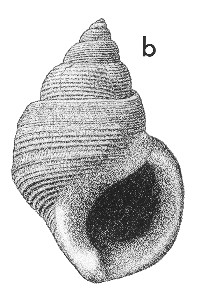
Revised descriptions of New Zealand Cenozoic Mollusca from Beu and Maxwell (1990)

 | Revised descriptions of New Zealand Cenozoic Mollusca from Beu and Maxwell (1990) | 
|
  (Pl. 42b): holotype of Struthiolaria convexa, GS1089, V21/f8482, Okauawa Stream, Kereru Road, central inland Hawke's Bay, late Nukumaruan (TM5763, GNS) |
Beu & Maxwell (1990): Chapter 15; p. 320; pl. 42 b.
Synonymy: Struthiolaria convexa Marwick 1924b, p. 188
Classification: Struthiolariidae
Description: Moderately large for genus (40-55 mm high), with moderately tall spire (slightly shorter than aperture), smoothly abutting suture to narrow, horizontal sutural ramp, evenly convex whorls, and normal, wide Pelicaria aperture with weakly sinuous, varicate outer lip meeting thick, smooth inner lip at shallow anterior notch. Sculpture of many low, narrow, widely spaced spiral threads only; in some specimens threads are grouped in positions corresponding to those of spiral cords of older species such as P. acuminata; weak axial ridges cross much of surface without forming nodules. Protoconch typical of genus, an initial large, low, slightly irregular, smooth dome of half a whorl followed by 1 whorl with horizontal, flattened upper surface and obvious shoulder angle, blending into rounded first spire whorl.
Comparison: Pelicaria vermis form convexa overlaps with the much more strongly sculptured P. vermis form acuminata (see above) and partly overlaps P. vermis form fossa in latest Nukumaruan rocks of Hawke's Bay. Most specimens of P. vermis form convexa can scarsely be distinguished from Castlecliffian-Recent specimens of P. vermis (Pl. 47u) by any characters at all, as it supposedly differs by having slightly weaker sculpture, less strongly shouldered whorls, and a lower incidence of shoulder nodules. Some particularly weakly sculptured specimens from Kupe Formation at Castlecliff, Wanganui, have been identified as P. convexa in the past, although they are indistinguishable from present-day, northern New Zealand, warm-water secimens of P. vermis. There is no doubt that the lack of a dispersive larval stage restricts genetic exchange between populations and allows a great deal of phenotypic variation in P. vermis, and intermediate specimens exist between all these forms, so Beu (2009) was confident that this is a single species.
Distribution: Nukumaruan. Okauawa Stream, Kereru Road, inland central Hawke's Bay, late Nukumaruan (type); very widespread and abundant in blue-grey siltstone throughout Hawke's Bay, northern Wairarapa and the Rangitikei river section, Wanganui basin; rare in southern Wairarapa. Specimens recorded from Castlecliffian rocks at Cape Kidnappers (Maraetotara Sand; Fleming in Kingma 1971) and at Castlecliff, Wanganui (Kupe Formation; Fleming 1953) are nearer to the form named P. vermis flemingi by Neef (1970); this is now a northern warm-water form restricted to the Bay of Plenty (see below).
Cite this publication as: "A.G. Beu and J.I. Raine (2009). Revised
descriptions of New Zealand Cenozoic Mollusca from Beu and Maxwell (1990). GNS
Science miscellaneous series no. 27."
© GNS Science, 2009
ISBN
978-0-478-19705-1
ISSN 1177-2441
(Included with a PDF facsimile file
copy of New Zealand Geological Survey Paleontological Bulletin 58 in CD version
from: Publications Officer, GNS Science, P.O. Box 30368 Lower Hutt, New
Zealand)